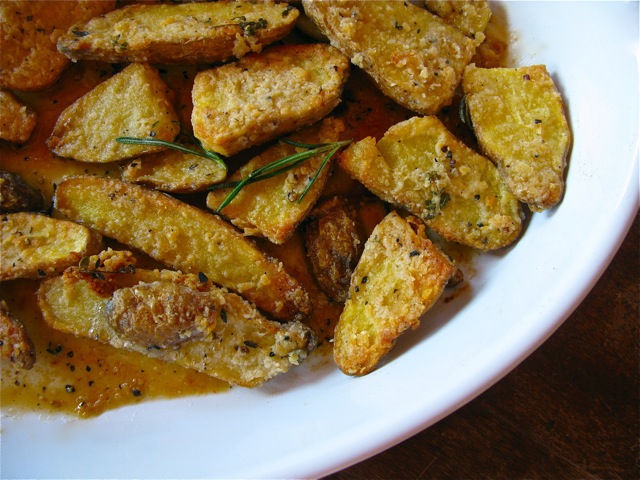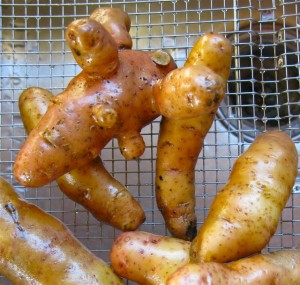Hello from the farm!
The days go by quickly here at the farm as we are preparing for the fall crops that will take us all the way into November. The tomato plants are going to put forth quite a harvest again this week--be ready :-) We're also getting ready for the Dining in the Fields event which is only a little more than a week away now. The fall crop seeds which have been planted in the last two weeks, have not received any rainfall, so we have been making it rain with considerable effort, thanks to hoses, sprinklers, and an able farm crew. Thank you Elizabeth, Law Reh and trainees for getting water on the fields!
Win some lose some
Judging by blog pictures, Pinterest and Facebook, one could easily conclude that farming is the idyllic practice of sitting around and gazing with appreciation at a calendar page freshly-picked tomato or pepper. With farming, we have our fair share of bumps in the road. On Monday, we spotted late blight on the cherry tomatoes. Late blight is the fungal disease that was responsible for the Irish potato famine and it is also quite adept at wiping out your tomato crop in just a matter of days. If you look at the cherry tomato plants you can see the blackened plant tissue. We immediately applied an organic treatment to prevent further damage and we'll hope that the Sungolds continue to do well.
A tough little critter called a flea beetle and his cohorts wiped out our field of broccoli, cabbage and cauliflower plants that were growing for fall harvest. We wanted to have those crops for you this fall, so we started over by buying plants from another farm and replanting. Hope with us that they will mature in time before the very hard freezes arrive. Never a dull moment when farming and working with weather, plants, insects and animals :-) We're grateful and very pleased at the abundant harvest of many good things this year including the tomatoes, melons, carrots, potatoes, Sungolds and others.
Need Tickets for Dining in the Fields? Sept 7th is Farm to Table Time!
Homefields, the organization that founded and owns the farm and land, is putting together the 2nd annual Dining in the Fields event. The meal will showcase the food grown here at the farm as presented by chefs Steve and Barb.
Stay connected as they fine-tune the menu, seeing what seasonal organic crops rise to the occasion as we approach the date. Facebook, email , and check out past sponsors, menu, and more here. Proceeds go to Homefields for the adjoining farm land that they secured for future vegetable growing.
Purchase tickets at: www.homefields.org
Purchase tickets at: www.homefields.org
Goodwill at Homefields Farm is on Facebook:
Check out our antics, glamour veggie photos, quips, goofy fun and more at:
https://www.facebook.com/pages/Goodwill-at-Homefields-Farm/121147947971207?ref_type=bookmark
Feedback wanted: How much do you value the carrots that we grow? We spend many times the effort on carrot growing than any other crop. Just send us an email saying:
a) very very highly
b) highly
c) somewhat
d) a little
e) not at all. (would not miss them)
b) highly
c) somewhat
d) a little
e) not at all. (would not miss them)

Purple Viking Potatoes are featured this week. These are not novelty potatoes, but are a great flavored, well textured potato that is also high in antioxidant anthocyanins known to control blood pressure, slow aging, and are good for heart health. They won't do your laundry though but they sure taste good. Pass the potatoes please.
Monthly Farm Tour:
Want to get a behind the scenes look at the workings of the farm? There is a monthly farm tour on the 1st Tuesday of the month at 9am. If you are planning to attend, please email sbreneman@yourgoodwill.org. Tour lasts approximately 30 minutes.
No tours during Dec/Jan/Feb due to Volcanic winter, ok, just joking about the Volcanic part)
No tours during Dec/Jan/Feb due to Volcanic winter, ok, just joking about the Volcanic part)
Torrential Downpour of Tomatoes Predicted: you may wish to seek shelter in a kitchen, wash, core and cut up your tomatoes, place in a large pot with a bit of added water, cook on medium, stir until soft, place in cone or mill type food mill and process for juice/paste. Cool and freeze in freezer boxes or can in a water bath canner. (You can see the beginnings of my sauce project last night)

Serving Suggestions for the harvest this week:
Purple Viking Potatoes: see the picture of the purple and pink-splashed potato up above.
Red River and Sterling White Onions: both of these are good storage onions and are desirable for just about any purpose.
Sweet Peppers: whether green, yellow, orange, red, or purple. bell shaped or horn shaped, we'll have a sweet pepper for you. Our perennial favorite is Carmen, a lipstick red bull's horn type sweet pepper.
Tomatoes: the tomato plants are going gangbusters. Look for the harvest to slowly decrease as fall approaches. Mmm, tomato and cheese sandwich anyone?
Eggplants: We really like the long slender Asian type eggplants! They are user friendly, mild and great for grilling with soy sauce, miso etc on the grill or use in any recipe that calls for eggplant--in short, treat them the same as the Italian "bell-type" eggplants.
Scallions: These mild-mannered onion family folks give an easy onion flavor to salads, sandwiches, stir fries and more. Or you could do the old classic buttered bread and sliced scallion treat: my grandparents talked a lot about enjoying them in spring. We found a few more.
Goodbyes:
Watermelons and cantaloupe: it was nice melon run, but sooner or later, we knew they'd be done. We hope you enjoyed them as much as we did.
Cucumbers: these are finished for this season, we're sad to see them go.
Carrots: carrots are really good roasted in the oven with some coconut, olive or peanut oil. Of course they are also good as carrot sticks or in salads. We will miss the fresh taste of farm carrots, it's just not the same getting them from the store.
Summer Squash: add raw to salads, steam lightly, or stir-fry. Don't overcook unless you like soft consistency.
Kohlrabi: sort of a mini-broccoli little crunchy dude, these are tasty raw and taste kind of like mild sweet broccoli. Usually eaten raw. Some people peel away the outer layer. May return in autumn.
Greens: these succumbed to the heat, with the exception of chard which continue to grow through the summer heat. We like to fry these in a skillet with butter or coconut oil until crisp, add some onions and saute them as well--a superb topping for rice, fried eggs or stand alone too.
Broccoli: Broccoli is dicey as a spring crop and the heat has made it flower and diminished its quality--look for a new crop in fall.
Garlic scapes: we hope you enjoyed the delightful flavor of these.
Lettuce heads: these have run their course and are stretching skyward--a precursor to bolting--flowering to make seed.
Lettuce mix--the leaves have given it their all and are now finished.
Garlic scapes: we hope you enjoyed the delightful flavor of these.
Lettuce heads: these have run their course and are stretching skyward--a precursor to bolting--flowering to make seed.
Lettuce mix--the leaves have given it their all and are now finished.
Green garlic: this is garlic harvested before the base swells and becomes a bulb. It has a milder flavor than bulb garlic and can be used anywhere garlic is called for. Keep refrigerated as you would green onions/scallions.
Cilantro: this herb has run its life cycle and is "bolting" or going to seed.
Thank You
Thank you trainees for an excellent harvest. Kudos to Law Reh and Elizabeth for setting up and running irrigation. Pat on the back to farm staff for getting in the last hurrah of brassica transplants, thank you Butch for welding the potato digger and thank you Bob for the shade umbrella on the weeder.
Have a great weekend,
Scott and the merry band of farmers
Thank you trainees for an excellent harvest. Kudos to Law Reh and Elizabeth for setting up and running irrigation. Pat on the back to farm staff for getting in the last hurrah of brassica transplants, thank you Butch for welding the potato digger and thank you Bob for the shade umbrella on the weeder.
Have a great weekend,
Scott and the merry band of farmers










